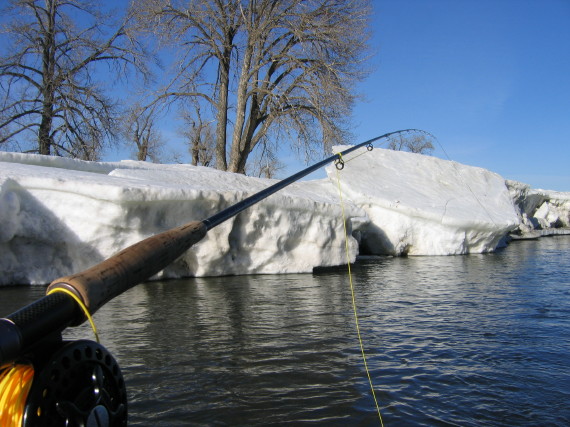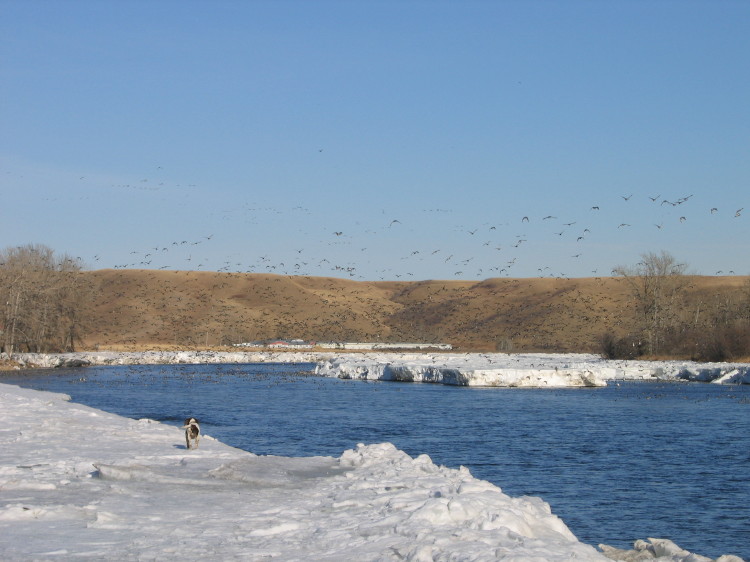
monger
-
Posts
3,054 -
Joined
-
Last visited
-
Days Won
305
Content Type
Profiles
Forums
Events
Store
Posts posted by monger
-
-
I'm getting tricky in my old age
-
Ya we had a helicopter lift the boat out at the end. No we were just wading.
-
-
Trout can adjust the amount of melanin released in their skin very quickly to help blend in with the substrate. You will see quite a bit of difference between a rainbow that spends a lot of time in the shallows versus one that lives in a deep, dark pool.
-
-
I think between whirling disease and a lake trout introduction into Yellowstone lake, the number of Cutts in the river has decreased from what it once was. I was last there in the late 80's and you could feed Cutts caddis flies as they sat in the eddy behind your legs. You could catch fish pretty much every cast then--14-23" Cutts. It was awful. The upper river is packed with fishermen, but the lower river was wide open. You could also try some of the rivers and tributaries coming from the NE corner of the park. There is also some nice lakes with trout and grayling in the park.
-
Don't wait much past Apr 20, after that most of the rainbows will have left the river in search of sex
-
Great sign Don, thanks for posting.
I have a problem with a lot of "organized religion" myself. Faith in God however is not a problem for me. People are sinful creatures so it always easy to find their faults. The truth does exist, its just that men keep trying to invent their own for personal gain.
-
He has a Dell, and they don't send you an operating system CD or driver CDs when you get your new computer. He said he can't even get to "safe" mode. Dell support told him he needs to get his hard drive copied before it gets restored. Any techs for hire? He tried the yellow pages, but everyone is busy.
-
I wonder if the casting platform could be used for sight fishing into a number of marl covered Bays in about two months?
-
Sundancefisher just called me to say his computer crashed. He wants to retrieve what he has on his hard drive before he does a restore. Any advice out there or techs available? I can send you his phone number by PM if anyone is around.
-
Very nice Tim. Can't wait to see your daughter hauling in fish in front of all the meat fishermen. What hook are you using for your bloodworm?
-
He's just got his "summerfallow camo" on. I don't like his chances come hunting season. Predators often select the "different" looking individual from the group.
Great shots, thanks for sharing
-
Awesome toon. I like the fact that they have that casting platform. I should have bought the 9ft one at the Max Bell fly fish show couple of years ago. The guy was willing to sell it for $800.
My buddy bought an Outcast (great sale) through Cabelas a couple of months ago, but he said they wouldn't ship it to Canada. He arranged a pickup in Montana. Were you able to get this Scadden shipped directly to you? What were the shipping costs?
-
Try Dee at Trout Chasers River Company. One of the best, and most experienced on the Bow.
-
You bet Russ. The larger diameter line definately is more bouyant. It's great that new technology has allowed us to use stronger line with much smaller diameters. Calm, slow moving water certainly calls for a bit more finesse as the fish have more time to inspect our offerings. It sounds like you have a great plan for those big, slow runs. Using less weight would also allow one to decrease corkie size if one was so inclined. Thanks for sharing your insights.
-
I've been using FOURTEEN lb mono for "worming" and streamer fishing for about 20 years. I place my weight between my two flies and it rests above a single hand knot I put in the mono (no slippage). When nymphing in fast flowing water you don't need fine line. My Dad used to drag soft hackles down and across on the Bow with TWENTY pound mono in the 70's (this was when the stuff was as big as a rope). He previously used 10lb but was just snapping off too many huge fish. I guess if you are using #18/20 nymphs you have to downsize accordingly. My suggestion would be to use the heaviest mono that can fit through the eye of the hook. Heavy leader decreases fighting time and therefore decreases lactic acid build up in the fish.
-
Because its so satisfying to catch fish on a fly that your buddies laugh at and say "that'll never work". It's even better when they whine later on in the day pleading for one of your "ugly" flies. Making your own flies gives you the opportunity to get the size and color just the way you like it--so you can pretend you are a little smarter than the fish.
-
Another problem with open spaces is that the "rich" will be able to circumvent the draw every year and get access to tags (from landowners) that the average resident has to wait a number of years to receive (from the government). Once we start selling off elk and mule deer to the highest bidder, what will stop the sale of other species later on? I wonder how loud the landowners in the rest of the province will yell when only the ranchers in WMU 300 and 108 get to make money off of PUBLIC WILDLIFE?
At a meeting in Calgary recently, one of the ranchers down by Waterton said that if this program that will allow him to sell hunting tags dosen't go through he will let a bunch of Natives come on his land and eliminate all the wildlife. Wow, what a great stewart of the land. Greed brings out the best in people.
-
Is this a proven pattern? I've heard that tadpoles contain a chemical that makes them undesirable for trout to eat.
-
Where I fish we also find lots of Daphnia feeding very early in the year. It looks like green porridge in the stomach.
-
Good show. I was wondering if you saw any fish in Big Earl's pool that looked like Rainbows? I have caught a few fish in that area that look and fight a way more like Rainbows than Cutts.
-
My buddy who was born and raised in Bowness says the number of whitefish around has drastically decreased in the last few years. He does quite a few "snorkeling surveys" to check to things out. He is not sure why the numbers are down. He has told me of snorkeling adventures in late summer/fall when there was so many whitefish you couldn't see the bottom in some areas. I would imagine the loss of whitefish fry must have an effect on the rest of the fish in the river. We used to have great fun nymphing for whitefish with a fish a cast about 20 years ago. There is also some very big pike that live in the river near Bowness Park.
-
Yzerman or Sakic. Total package, great leaders by example, no excuses
Fleury? Anybody who dives that much is an embarrassment to the game. Zero class




Belize Fishing Clothing Gear
in General Chat - Fly Fishing Related
Posted
I pity any sting ray that ends up under the great bulktitude that is Sundancefisher. Hopefully the substrate is soft enough for the shark to escape.